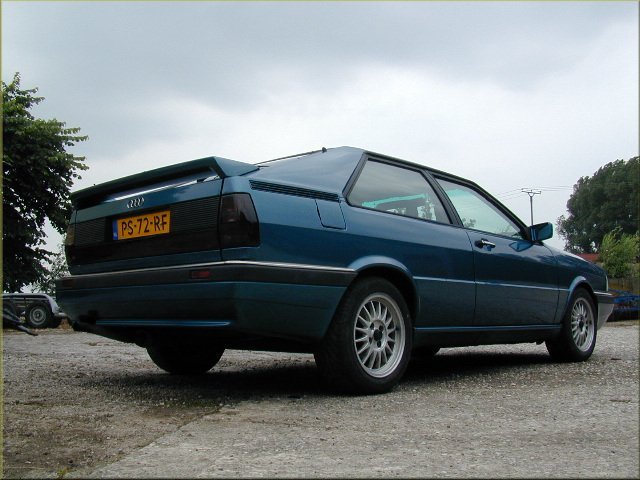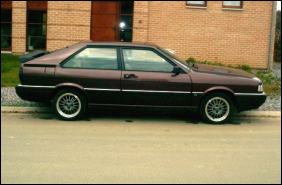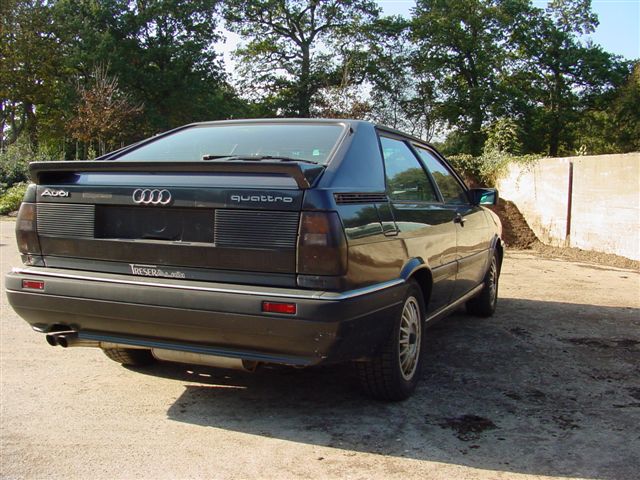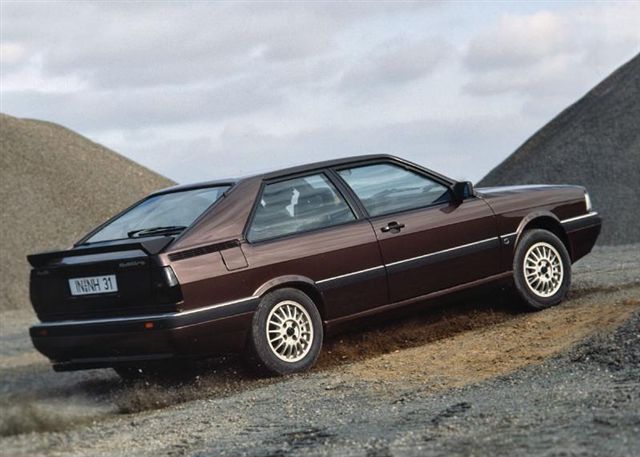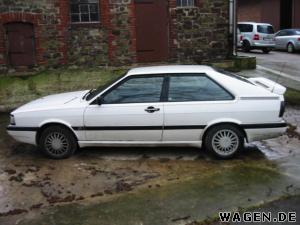The Coupe Quattro
My CQ
Ongoing Restoration
Gallery
Info / Data
Suppliers
Links
T85q.com
A Buyers Guide (remember Caveat Emptor!)
The best advice you'll get on any used car you are considering will come from a trained mechanic. Get an independent inspection from a knowledgeable Audi mechanic if you are serious. The one or two hours labour you pay for will be the best investment you make in the car! Here is a list of things you can check out on a Type 85 Coupe or Coupe quattro. rolex replica sale This is a worst case list; not all cars have these problems, and some are easy and cheap to fix.
Let’s get one thing clear from the outset; these cars are getting old with the last ones being built in 1987/88. Most will have had several owners by now and will be showing over 100,000 miles/160,000km. Mileage in itself is not a problem for these cars mechanically, provided they have been cared-for by previous owners. cartier replica sale The bodywork on the other hand may not be quite so good – remember these cars were not galvanised and therefore rust can be found, particularly on those cars imported from the UK as they tend to sit outside a lot and are used on salty roads in the winter.
Bodywork and Interior
Choose a car to buy with good bodywork as it is uneconomical to restore a rusty car.
Although not galvanised, these cars were well built and painted. The presence of
rust either shows major neglect or badly-repaired crash damage. If you see
either, go and find another car. rolex replica uk The A-pillars on these cars are prone to
rusting out at the bottom corners of the windscreen and on the panel where the
wipers come out, so check for signs of filler and re-spraying in this area. This
is not a problem if a proper repair has been done. Door hinge attachment points
have been known to rust through.
Look for rust underneath the doors and
also in the rear wheel arches.
Do the gaps between the panels all line up
evenly?
Is the paint the same colour on all the panels?
Underneath
the car there should not be much evidence of corrosion; the underside is
well protected. The interiors of these cars can
suffer, particularly the driver's seat, anything that is ripped or torn
will be difficult to replace, as the cloth is becoming difficult to find.
There are however a lot of common components inside that went onto the
Audi 80/90 of this era, so switches and other bits are still readily
available, especially from your local scrap yard.
Engine 2226cc 5-cylinder 136bhp
Usually good for big mileage if well cared for which means proof of regular oil changes and
servicing, preferably at an Audi dealer or specialist using good quality oil and
filters, as this is the key to long engine life. omega replica sale The engine itself is very
strong, the weaker points being hydraulic tappets that tap when they get old,
worn valve guides and oil stem
seals causing excessive oil consumption. When
driving the car the engine should be smooth all the way to 6000 rpm and idle at
850 to 900 rpm without fluctuation. It should not burn any oil when revved hard
either. The more receipts and history the car has
the better, buying one with no service
history is risky. Be suspicious if the engine is too clean, the seller may
have had it steam cleaned to conceal oil leaks. Leaks can occur from the
front cam and crank seals, cam cover gasket or the sump gasket. None of
these problems are too expensive to fix, but are a good indicator of the
quality of maintenance and a good bargaining point.
When was the cam belt last changed? This is crucial because if that belt goes, the valves and pistons will become intimate. hublot replica uk You'll pay lots of labour (about 4.5 hours) to get the belt replaced, but it's peanuts compared to what it costs to fix an engine that has interfered with itself. The official service interval for the belt is 80,000 miles / 130,000km, but it is recommended to have it done every 60,000 miles/100 000km to be on the safe side. If the cam belt needs changing, install a new water pump, water pump seal, camshaft front seal and crankshaft front seal while the front of the car is apart. It will save more dismantling later.
Fuel Injection
This car uses the well-proven Bosch K-Jetronic system and is usually very reliable. If the car starts quickly from cold, is smooth to drive whilst it is in its warming up phase and starts easily when hot then you should be ok. replica watches Known problems are noisy fuel pumps (under the car just forward of the left rear wheel), fuel pump relays that fail, injectors that eventually leak causing starting problems and bad running, breather hoses getting old and collapsing and also the idle stabilisation valve (ISV) can malfunction giving erratic idling. Look closely at the distributor cap, rotor arm and plug leads for their condition and check to see if the car is being run on triple electrode spark plugs from Bosch or NGK. Coils very rarely give trouble.
Transmission
The transmission is very strong on these cars, low gearbox and rear differential oil can cause premature wear and failure. Any serious whining and clunking from these components means trouble, although it may be a loose or worn mount on the gearbox or rear subframe. A judder when pulling the clutch up probably means that the clutch is worn or oil is getting on to it. The clutch will last over 100,000 miles. Gearbox mountings can also cause a similar effect. Check to make sure that the differential locks engage and disengage. Some driveline shunt when driving the car is acceptable but an excess is not. How do you know the difference? It is best to drive a few cars and compare. Check all four driveshafts for wear and split rubber boots. The gear change on these cars does vary with age, mileage and what type of oil is in the box, it should be smooth and all gears engage and disengage easily. Look also for oil leaks from both box and diff, not usually a big problem but can make a mess of the driveway. A stiff gear change may indicate the original gear oil is still in the gearbox. Changing it for a modern synthetic will make the gearshift much easier and lengthen the life of the gearbox.
Clutch master or slave cylinder problems.The symptoms can include clutch pedal not returning all the way to rest position unless encouraged. Each cylinder new is about $200-400, there are rebuild kits available, and sometimes just changing the fluid will bring them back to life. Dead wheel bearings. Noise is apparent on the move, goes up and down with speed. Replacement wheel bearing kits at a dealer can be up to NZ$180. Try UK parts supply houses, some bearings £10 sterling ($30).
Suspension / Steering
There are a lot of rubber bushes in the suspension of these cars and by 100,000 miles they do start to wear out. A test drive will indicate suspension problems. It should feel tight and precise with no thumping and wallowing around; the car should feel pretty glued to the road. If it feels nervous and vague work will be required on alignment and suspension components. The favourite things to wear are dampers - check for leaks. The bounce test does not seem to really be effective due to the stiff springs, wait till the road test. Bump stops, top mounts, A-arm bushes, sub-frame bushes, ball joints and track rod ends should all be checked. In my experience if you are replacing some of these do the whole lot and save yourself more dismantling later. Suspension work will bring about improvements in handling precision and steering feel. Worn components should be changed as soon as practicable, as not doing so will stress other components and make them fail sooner. Many of these things are consumables, and having to do some work is expected. Once fully sorted the car is a joy to drive, if it drives well already, then great. Check the steering for leaks from the pump and steering rack, it should be smooth in operation with no nasty clonks, vague steering can be a sign of worn suspension, very heavy steering can mean that the pump is not giving enough assistance. Generally there are no major dramas with the steering on these cars.
Loose/worn tie rod ends cause squirrelly handling and some clonking while turning at low speed. The best case it is a free fix, just a 15mm (?) spanner, and the worst case is tie rod end replacement. The car could also could need a wheel alignment, check for uneven tire wear. Correct wheel alignment has a dramatic effect on handling and tyre wear.
Brakes
The Quattro uses disc brakes all round (256mm vented at the front and 245mm solid discs at the rear) which are just about ok if used hard, though an upgrade would improve things. The car should stop without pulling to one side with a good firm pedal, the hand brake should be easy to apply and have 3 to 4 inches of travel. The main problem to look for is with the rear callipers; they can stick on causing the pads to overheat. The only cure is to fit new ones and check the handbrake cables are in good order. Prevention involves ensuring the brakes are well used every so-often. The brake fluid should be changed every year - dark coloured fluid means it hasn't been done for quite a while.
Electrics
In my experience the electrics are pretty good, although some would disagree. Things to go are electric window lifters, electric door mirrors, window switches and the rear wiper motor. Headlight reflectors lose their silver coating, these can be replaced by removing the headlight, taking the glass off and buying some re-chromed or new ones. It is a lot cheaper than buying a whole new headlight.
Burnt out electrical switch lights can be fixed by careful dismantling and replacement of the bulb – obtainable from auto electrical suppliers. Switches are typically around NZ$40-80 each, to fix a $1 bulb.
Inoperative radiator fan. The fans will sometimes fail because of stress on the wiring harness, or the motor may just freeze up. Also, it might not work because of a bad temperature sensor. Be sure that the fan comes on when the A/C is engaged, and when the engine is hot with the car both on and off. This is a common problem.
Noisy or inoperative power windows. A fix is at best free (clean out switch), and at worst it will be about $250 for a new regulator assembly. Prevention involves lubricating tracks in window frame to reduce friction and exercising the window regularly.
Air Conditioning
Most air conditioning problems are caused by infrequent use of the system. It needs to be run for at least 10 minutes per month. Air conditioning in this model can either be factory-installed (in which case there will be the word “Climatronic” on the ventilation control panel together with a push-button air conditioning switch) or an Audi-approved aftermarket system manufactured by Diavia. The air conditioning switch in this case will be mounted on the small panel behind the steering wheel next to the ABS on/off button where the seat heater controls would be mounted, or possibly between the window switches on the centre console. Potential air con problems include leaking seals, bad hoses, or a hole in the condenser, which can be welded for cheap by any radiator repair shop. Another possibility is an associated electrical fault, such as a faulty relay for air con activation.
Summary
Any car of this age will probably be suffering from similar ailments; the reward is having a great fun car to drive that, if looked after, will give you years of pleasure and fun motoring. Above all else a decent service history backed up by receipts is essential when looking to purchase such a car. If well-maintained and in good condition, the Type 85 Coupe is a reliable car which is inexpensive to run. If possible, drive two or three to get the feel of how they drive before buying one (assuming you can find two or three for sale). As time goes on these cars are becoming rare, and finding a well cared-for example is becoming more difficult.
Acknowledgements
Iain Atkinson from audiurquattro.de
Un-named author from 20v.org website
Michael
Brown
Microsoft for helping to raise my blood
pressure through their consistent inability to write concise HTML
code
Click Here to email me
